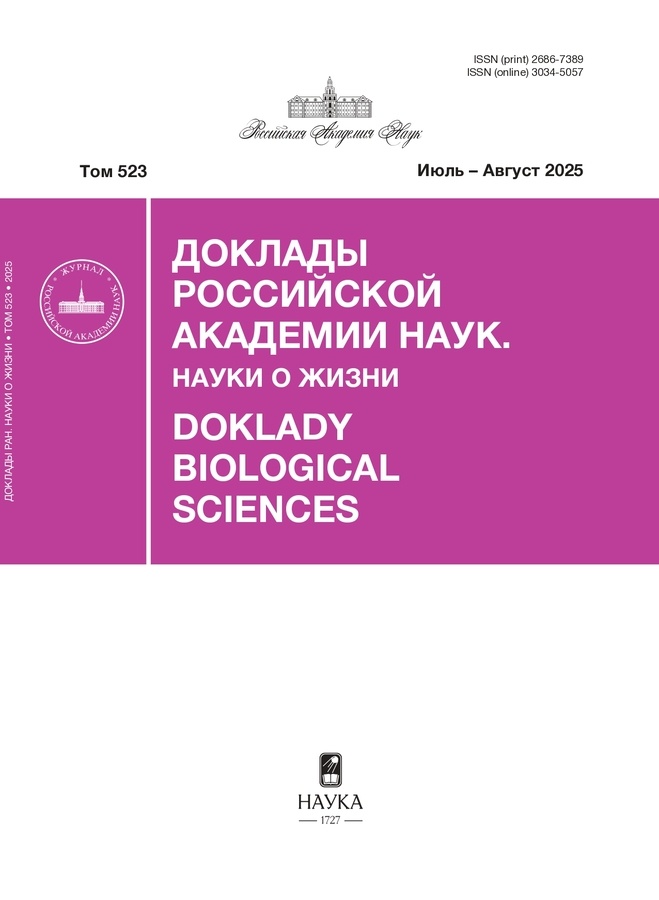ВОЗДЕЙСТВИЕ АГОНИСТА ХОЛЕЦИСТОКИНИНА-4 D-ГБ-115 НА ХАРАКТЕР ДВИГАТЕЛЬНОЙ АКТИВНОСТИ PARAMECIUM CAUDATUM
- Авторы: Груздев Г.А.1, Соболева Л.В.1, Каменский А.А.1
-
Учреждения:
- Московский государственный университет имени М.В. Ломоносова
- Выпуск: Том 510, № 1 (2023)
- Страницы: 263-267
- Раздел: Статьи
- URL: https://rjpbr.com/2686-7389/article/view/651107
- DOI: https://doi.org/10.31857/S2686738923600024
- EDN: https://elibrary.ru/QHLRZY
- ID: 651107
Цитировать
Полный текст
Аннотация
В работе исследовалось воздействие ГАМК в различных концентрациях и D-ГБ-115 в концентрации 10–7 М на поведение Paramecium caudatum. Показано, что ГАМК повышает двигательную активность и изменяет стратегию движения этих простейших, причем зависимость “доза–эффект” носит куполообразный характер, что можно объяснить присутствием в наружной мембране парамеций рецепторов двух видов к ГАМК: ГАМК-А и ГАМК-Б. Диапазон действующих концентраций ГАМК находится в пределах от 10–3 до 10–13 М. Исследовано воздействие на поведение инфузорий фармакологических агентов, взаимодействующих с ГАМК-системой: нембутала и холецистокининовой системой: D-ГБ-115.
Ключевые слова
Об авторах
Г. А. Груздев
Московский государственный университетимени М.В. Ломоносова
Автор, ответственный за переписку.
Email: Gleb-neuro.phys@mail.ru
Россия, Москва
Л. В. Соболева
Московский государственный университетимени М.В. Ломоносова
Email: Gleb-neuro.phys@mail.ru
Россия, Москва
А. А. Каменский
Московский государственный университетимени М.В. Ломоносова
Email: Gleb-neuro.phys@mail.ru
Россия, Москва
Список литературы
- Hobson-West P., Davies A. Societal Sentience: Constructions of the Public in Animal Research Policy and Practice // Sci Technol Human Values. 2018. V. 43. № 1. P. 671–693.
- Gruzdev G.A., Karpukhina O.V., Yakunin V.G., et al. Effect of Low-Temperature Atmospheric Pressure Plasma on Paramecium caudatum Cell Culture // Moscow Univ Biol Sci Bull. 2022. V. 76. P. 244–248.
- Gruzdev G.A., Karpukhina O.V., Inozemtsev A.N., et al. Method for Primary Screening of Pharmaceuticals on the Paramecium caudatum Eukaryotic Cell Model // Dokl Biochem Biophys. 2022. V. 502. P. 36–39.
- Gudasheva T.A., Kir’Yanova E.P., Kolik L.G., et al. Design and synthesis of cholecystokinin-4 dipeptide analogues with anxiolytic and anxiogenic activities // Russ J Bioorganic Chem. 2007. V. 33. P. 383–389.
- Schindelin J., Arganda-Carreras I., Frise E., et al. Fiji: An open-source platform for biological-image analysis // Nat. Methods. 2012. V. 9. P. 676–682.
- Груздев Г.А., Карпухина О.В., Иноземцев А.Н., et al. Анализ двигательной активности инфузорий Paramecium caudatum как тест-система оценки свойств адреналина // Экспериментальная и клиническая фармакология V. 85. P. 41–45.
- Schlaepfer C.H., Wessel R. Excitable Membranes and Action Potentials in Paramecia: An Analysis of the Electrophysiology of Ciliates // J Undergrad Neurosci Educ. 2015. V. 14. № 1. P. 82–6.
- Ramoino P., Milanese M., Candiani S., et al. Gamma-amino butyric acid (GABA) release in the ciliated protozoon Paramecium occurs by neuronal-like exocytosis // J Exp Biol. 2010. V. 213. P. 1251–8.
- Germann A.L., Burbridge A.B., Pierce S.R., et al. Activation of the Rat α1β2ε GABA-A Receptor by Orthosteric and Allosteric Agonists // Biomolecules. 2022. V. 12. P. 1–16.
- Csaba G. The hormonal system of the unicellular Tetrahymena: a review with evolutionary aspects // Acta Microbiol Immunol Hung. 2012. V. 59. P. 131–156.
- Siniscalchi A., Rodi D., Cavallini S., et al. Effects of cholecystokinin tetrapeptide (CCK4) and of anxiolytic drugs on GABA outflow from the cerebral cortex of freely moving rats // Neurochem Int. 2003. V. 42. P. 87–92.














